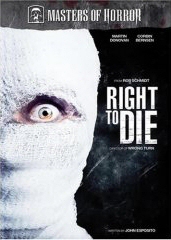
Continuing its mission of giving a voice to some of the genre's most imaginative directors, Masters of Horror: Season Two has given fans television's harshest, most psychologically disturbing moments of terror. Also brought over from season one -- perhaps even surpassing it -- is the cutting depth of social criticism inherent in almost every episode. Not content to whip out a story that simply scares, Right to Die also seeks to challenge, testing our political and moralistic stances on hot button issues that general television ignores. While the rest of our brain dead culture watches idiots embarrass themselves on American Idol, fans of emotionally intensive horror are getting both chills and drama served up in philosophically rich fashion on Showtime. Anchor Bay continues its celebration of the successful genre series by releasing director Rob Schmidt's vivisection of love, life, and laws . . . Of both Man and the supernatural.
Directed by Schmidt, a relatively new director when compared with some of the other talent involved in the series, Right to Die displays the same immediacy, intellectual proficiency, and solid horrors that the director displayed in his first feature Wrong Turn -- but with a more intelligent story. The script is daringly amoral, tackling painful problems without reducing the equation to overly simplistic good or bad arenas of thought. This, and the depths of emotion reached by characters, make the episode extremely touching and terrifying . . . and not just a little depressing! Cliff (Martin Donovan) is a conflicted husband forced to watch his charred vegetable of a wife suffer in a coma after an automobile accident. As Abby wreaks supernatural vengeance on anyone who attempts to capitalize off her condition, Cliff struggles with vulture-like reporters, relatives, and his own conscience . . . The later of which may unearth a secret that will destroy him.
Right to Die is a near perfect symbiosis between solid horrific storytelling and political subtext, having fun with its scares while managing to challenge status quo ethics. Using as context one of the more troublesome dilemmas of medical science, and personalizing it for the individual, the episode approaches the matter of life support and a person's rights to die more intimately than straight drama has ever attempted, and because you're made to care for the characters, the tragedy hits home.
Hard.
While the spectral element is satisfying, bringing a greater sense of urgency and depth to the narrative, the all too real scenes of a loved one suffering on a hospital table remain the show's most potent, terrible images. These are the ones that will stick with audiences. Emotionally, this episode drives home pain and the fear of loss more powerfully than any of the MOH episodes, surpassing in controversial approach and intimacy even Homecoming and Pro-Life. This is not fun horror so much as a subversive, sombre tragedy with horrific elements. Terror may be the name of the game but in this case the trauma and heartache of loosing loved ones is paramount. Just as effective is the conflict the main character has to face between conscience and Law, as again the genre accomplishes what other artistic forms of modern entertainment are too afraid to do, showing the Law as an impersonal machine operating for all the wrong reasons. Human dignity and life are buried beneath red tape and court orders. Truly scary stuff, particularly because it is grounded in the miseries of the everyday.
Anchor Bay continues giving the MOH series love with this new transfer, presenting Right to Die in an anamorphic widescreen aspect ratio of 1.78:1. The picture is, as usual, crisp and clean, with no grain or distortion. Colors are bold and images clear, lending further life to this parable of grief, pain, and ghostly vengeance. The audio track is featured in Dolby Digital and Dolby Surround 2.0. Both are clean and fresh sounding, blending score and effects evenly and with no trace of disruption or scratching. Extras are the usual blend of the informative with the self-promotional. Featured first is "Burnt Offerings: Making of Right to Die," which examines the problems and challenges of making the picture. "Flay-O-Trish" is as darkly humorous as it sounds, examining the effects and make-up of the shoot. Perhaps the most detailed and meatiest extra is the "Commentary" with director Rob Schmidt," as he discusses his experience working with the MOH crew, his casting, his career in general, and his feelings about this project's story and social criticisms. Less interesting is the "Storyboard Gallery" and DVD-ROM "Screenplay."
Review by William P. Simmons
| Released by Starz/Anchor Bay (USA) |
| Region 1 - NTSC |
| Not Rated |
| Extras : |
| see main review |